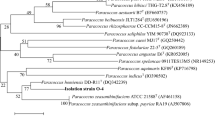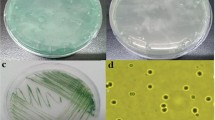Abstract
We examined the selective inhibitory potential of rice hull extract on the toxic cyanobacterium Microcystis aeruginosa, in comparison with inhibitory effects on two green algae (Ankistrodesmus convolutus and Scenedesmus quadricauda) and a zooplankton (Daphnia magna) species. The inhibitory effect of rice hull extract, measured by algal growth or zooplankton survival using four different concentrations of extract (1, 10, 100 and 1000 μg L−1), was highest on Microcystis strains (average: 98%, range: 95%–99%), followed by D. magna (average: 22%, range: 10%–47%), A. convolutus (average: 20%, range: 16%–24%), and S. quadricauda (average: 8%, range: 0%–15%). Rice hull extract had only a small effect on the growth of the green algae and Daphnia, particularly in the range 1–100 μg L−1, and the inhibitory effect was somewhat diminished even at the 1,000 μg L−1 level, at the end of the experimental period, especially for Daphnia. Our study indicates that rice hull extract has a strong specific algicide potential when used to combat M. aeruginosa.


Similar content being viewed by others
References
Allen MM (1968) Simple conditions for the growth of unicellular blue-green algae on plates. J Phycol 4:1–4. doi:10.1111/j.1529-8817.1968.tb04667.x
Carmichael WW (2001) Health effects of toxin-producing cyanobacteria: “The CyanoHABs”. Human Ecol Risk Assess 7:1393–1407
Chung IM, Kim KH, Ahn JK, Chun SC, Kim CS, Kim JT, Kim SH (2002) Screening of allelochemicals on barnyardgrass (Echinochloa crus-galli) and identification of potentially allelopathic compounds from rice (Oryza sativa) variety hull extracts. Crop Prot 21:913–920. doi:10.1016/S0261-2194(02)00063-7
Chung IM, Ali M, Ahmad A, Chun SC, Kim JT, Sultana S, Kim JS, Min SK, Seo BR (2007) Steroidal constituents of rice (Oryza sativa) hulls with algicidal and herbicidal activity against blue-green algae and duckweed. Phytochem Anal 18:133–145. doi:10.1002/pca.961
Cooke GD, Welch EB, Peterson SA, Nichols SA (2005) Restoration and management of lakes and reservoirs, 3rd edn. CRC, Taylor & Francis, Boca Raton 591 pp
Everall NC, Lees DR (1997) The identification and significance of chemicals released from decomposing barley straw during reservoir algal control. Water Res 31:614–620. doi:10.1016/S0043-1354(96)00291-6
Ferrier MD, Butler BR Sr, Terlizzi DE, Lacouture RV (2005) The effects of barley straw (Hordeum vulgare) on the growth of freshwater algae. Bioresour Technol 96:1788–1795. doi:10.1016/j.biortech.2005.01.021
Jančula D, Suchomelová J, Gregor J, Smutná M, Maršálek B, Táborská E (2007) Effects of aqueous extracts from five species of the family Papaveraceae on selected aquatic organisms. Environ Toxicol 22:480–486. doi:10.1002/tox.20290
Jang MH, Ha K, Lucas MC, Joo GJ, Takamura N (2003) Toxin production of cyanobacteria is increased by exposure to zooplankton. Freshw Biol 48:1540–1550. doi:10.1046/j.1365-2427.2003.01107.x
Kim JS, Kim JC, Lee S, Lee BH, Cho KY (2006) Biological activity of L-2-azetidinecarboxylic acid, isolated from Polygonatum odoratum var. pluriflorum, against several algae. Aquat Bot 85:1–6. doi:10.1016/j.aquabot.2006.01.003
Körner S, Nicklisch A (2002) Allelopathic growth inhibition of selected phytoplankton species by submerged macrophytes. J Phycol 38:862–871. doi:10.1046/j.1529-8817.2002.t01-1-02001.x
Lürling M (2006) Effects of a surfactant (FFD-6) on Scenedesmus morphology and growth under different nutrient conditions. Chemosphere 62:1351–1358. doi:10.1016/j.chemosphere.2005.07.031
Men YJ, Hu HY, Li FM (2007) Effects of the novel allelochemical ethyl 2-methylacetoacetate from the reed (Phragmitis australis Trin) on the growth of several common species of green algae. J Appl Phycol 19:521–527. doi:10.1007/s10811-007-9165-8
Nakai S, Inoue Y, Hosomi M, Murakami A (2000) Myriophyllum spicatum-released allelopathic polyphenols inhibiting growth of blue-green algae Microcystis aeruginosa. Water Res 34:3026–3032. doi:10.1016/S0043-1354(00)00039-7
Oliver RL, Ganf GG (2000) Freshwater blooms. In: Whitton BA, Potts M (eds) The ecology of cyanobacteria: their diversity in time and space. Kluwer, Dordrecht, pp 149–194
Park MH, Han MS, Ahn CY, Kim HS, Yoon BD, Oh HM (2006a) Growth inhibition of bloom-forming cyanobacterium Microcystis aeruginosa by rice straw extract. Lett Appl Microbiol 43:307–312. doi:10.1111/j.1472-765X.2006.01951.x
Park MH, Hwang SJ, Ahn CY, Kim BH, Oh HM (2006b) Screening of seventeen oak extracts for the growth inhibition of the cyanobacterium Microcystis aeruginosa Kütz. em. Elenkin. Bull Environ Contam Toxicol 77:9–14. doi:10.1007/s00128-006-1025-8
Park MH, Chung IM, Ahmad A, Kim BH, Hwang SJ (2009) Growth inhibition of unicellular and colonial Microcystis strains (Cyanophyceae) by compounds isolated from rice (Oryza sativa) hulls. Aquat Bot 90:309–314. doi:10.1016/j.aquabot.2008.11.007
Pillinger JM, Cooper JA, Ridge I (1994) Role of phenolic compounds in the antialgal activity of barley straw. J Chem Ecol 20:1557–1569. doi:10.1007/BF02059880
Pillinger JM, Gilmour I, Ridge I (1995) Comparison of antialgal activity brown-rotted and white-rotted wood and in situ analysis of lignin. J Chem Ecol 21:1113–1125. doi:10.1007/BF02228315
Pinto G, Pollio A, Previtera L, Temussi F (2002) Biodegradation of phenols by microalgae. Biotechnol Lett 24:2047–2051. doi:10.1023/A:1021367304315
Shirai M, Matumaru K, Ohotake A, Takamura Y, Aida T, Nakano M (1989) Development of a solid medium for growth and isolation of axenic Microcystis strains (cyanobacteria). Appl Environ Microbiol 55:2569–2571
van Donk E, van de Bund WJ (2002) Impact of submerged macrophytes including charophytes on phyto- and zooplankton communities: allelopathy versus other mechanisms. Aquat Bot 72:261–274. doi:10.1016/S0304-3770(01)00205-4
Welch IM, Barrett PRF, Gibson MT, Ridge I (1990) Barley straw as an inhibitor of algal growth I: studies in the Chesterfield Canal. J Appl Phycol 2:231–239. doi:10.1007/BF02179780
Acknowledgments
This work was supported by the Korean Ministry of Environment as “The Eco-technopia 21 project” (2007-06003-0020-1), and by the Korea Research Foundation Grant (KRF-2006- 351- D00026).
Author information
Authors and Affiliations
Corresponding author
Rights and permissions
About this article
Cite this article
Park, MH., Kim, BH., Chung, IM. et al. Selective Bactericidal Potential of Rice (Oryza sativa L. var. japonica) Hull Extract on Microcystis Strains in Comparison with Green Algae and Zooplankton. Bull Environ Contam Toxicol 83, 97–101 (2009). https://doi.org/10.1007/s00128-009-9732-6
Received:
Accepted:
Published:
Issue Date:
DOI: https://doi.org/10.1007/s00128-009-9732-6




